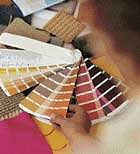
With the festive season coming up, it’s time to dress up the interiors of your house too. How about dabbling with some paint yourself rather than handing over the job to a painting contractor?
You too can impart that impeccable look to the interiors of your house with these tips from professionals.
Choosing the right paint
Which paint? Water-based (latex) paint is convenient. Just soap and water can clean brushes or hands after a day’s work. Oil-based (alkyd) paints require odorous solvents or turpentine for the clean-up and take longer to dry. But, they are more durable.
Repainting with the same colour? One coat will suffice. You’ll need a gallon of paint to cover an 8x12 ft. room with an 8-ft ceiling. A change of colour requires a double coat. Paint comes in different finishes. High gloss paint is more durable, stain-resistant and easier to wash but makes the imperfections on the surface conspicuous. It is best suited for heavy-duty areas such as kitchens, living rooms etc.
Flat paint hides surface imperfections and presents a uniform, non-reflecting appearance. Stain removal, being difficult, is best suited for lesser-used areas.
You’ll require three-inch and four-inch brushes. You need not clean up the brushes each time you take a break. Seal the brush or roller in a plastic bag. Keep it in the freezer.
Remove it an hour before you resume your painting. It is then ready for use.
Open the paint can and before stirring it, make little holes in the can’s lip with a nail to prevent paint from dripping when it flows back into the can after you pour some into the roller tray or a smaller can.
The shade of paint varies slightly from can to can, though the labels mention the same colour.
Using one can at a time shows the difference clearly on your walls. So, pour all the paint into a huge bucket. Stir it and pour it back into the cans.
Before starting to paint
Next, the preparations. Move furniture out of the room. Or, to the room’s centre. Cover them and floor too with old sheets or blankets. Scrape the walls with sandpaper. A rough surface grips the new paint better. Plus, painting over a dirty surface causes the new paint to start peeling after it dries. Scraping prevents this. Fill up small cracks/nail-holes with joint compound and spread it smoothly on the wall. After it dries, smoothen the patch with sandpaper. Paint one wall at a time. First ‘cut in edges’. Demarcate the edges and wall corners by applying paint about three-four inches wide with a paintbrush. Paint the rest of the wall with a roller. Fill the roller evenly, completely covering its surface, to avoid streaks/drips.
Painting in a straight line up and down will show the brush marks prominently. Rather, paint in a zigzag pattern. Cover 3-4 sq.ft. at a time. Start at the wall’s top portion and push the roller away from you. Paint a huge ‘M’ shape. Zigzag back over the same area until it is filled in. Paint the next 3-4 sq.ft. below the first until that part of the wall is completely painted down upto the floor. Now move to the top next to the first painted portion and similarly paint in parts upto the floor.
Apply the second coat after the first is fully dry. Else, the paint surface will crackle, leaving rough patches under the surface paint. Applying the paint too thickly makes it drip down the wall in a thick line. If the outer surface dries before the heavily painted coat underneath, the surface wrinkles. So, apply paint in thin layers. Also, smoothen out drip-lines while they’re still wet.